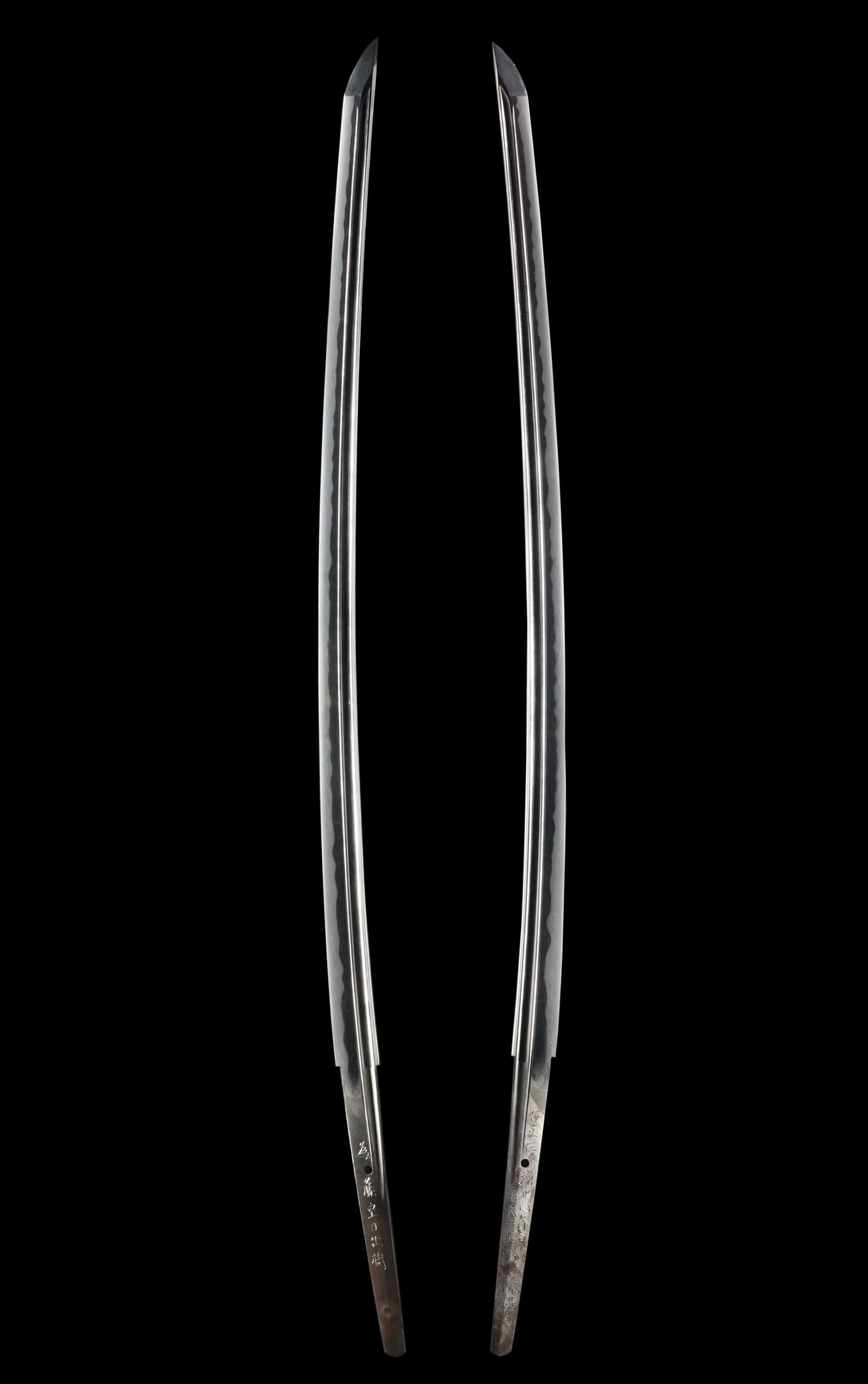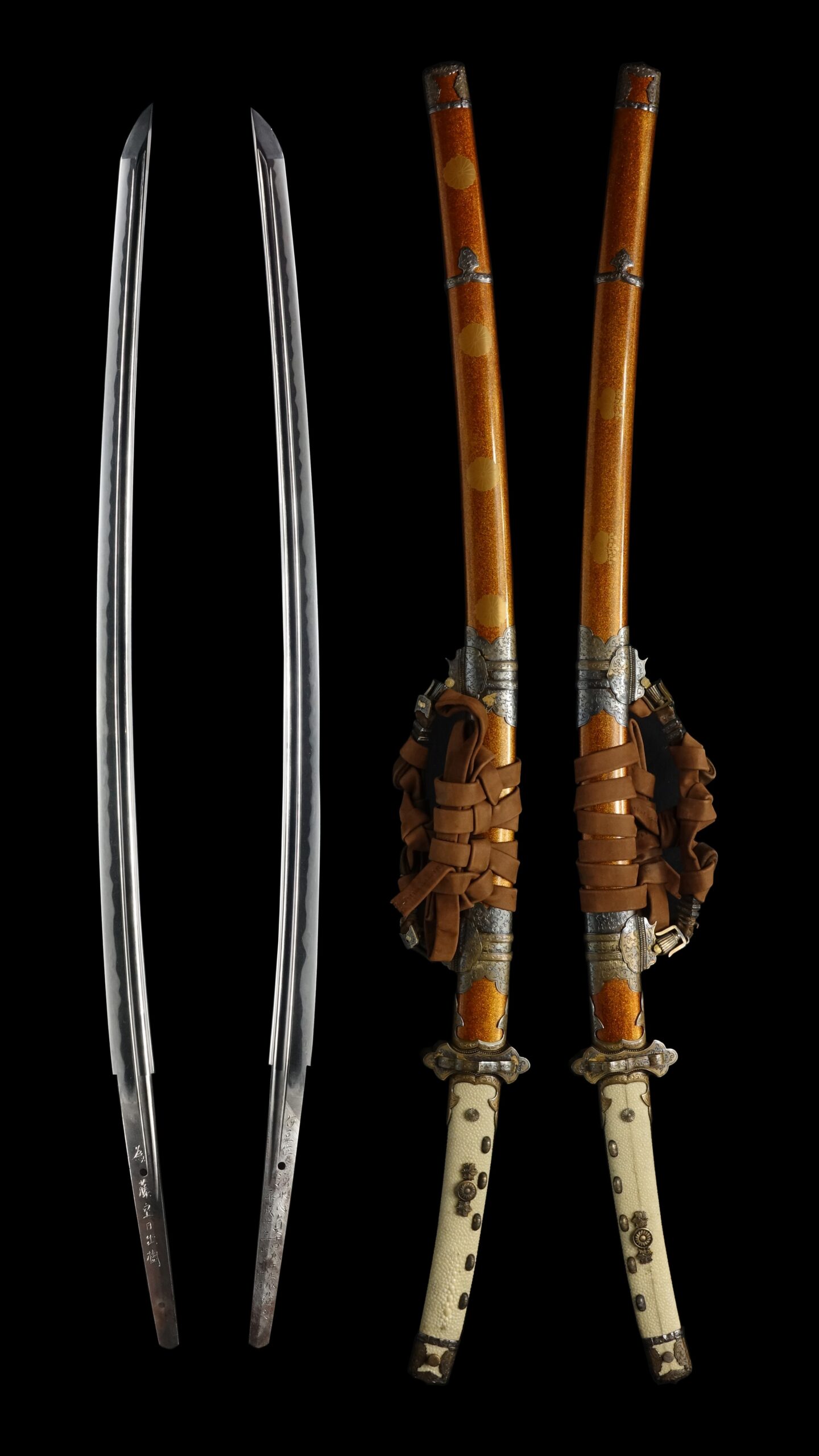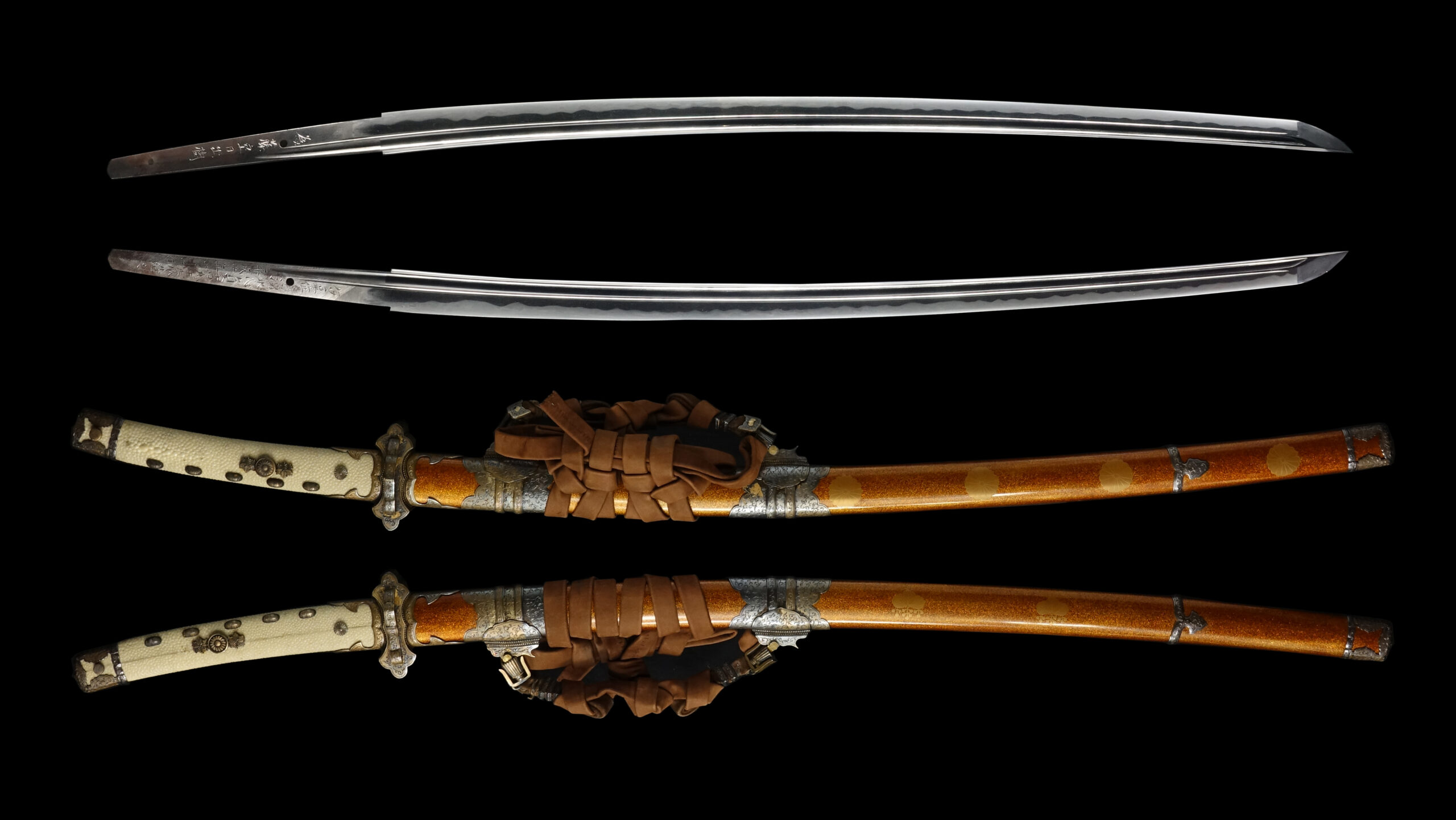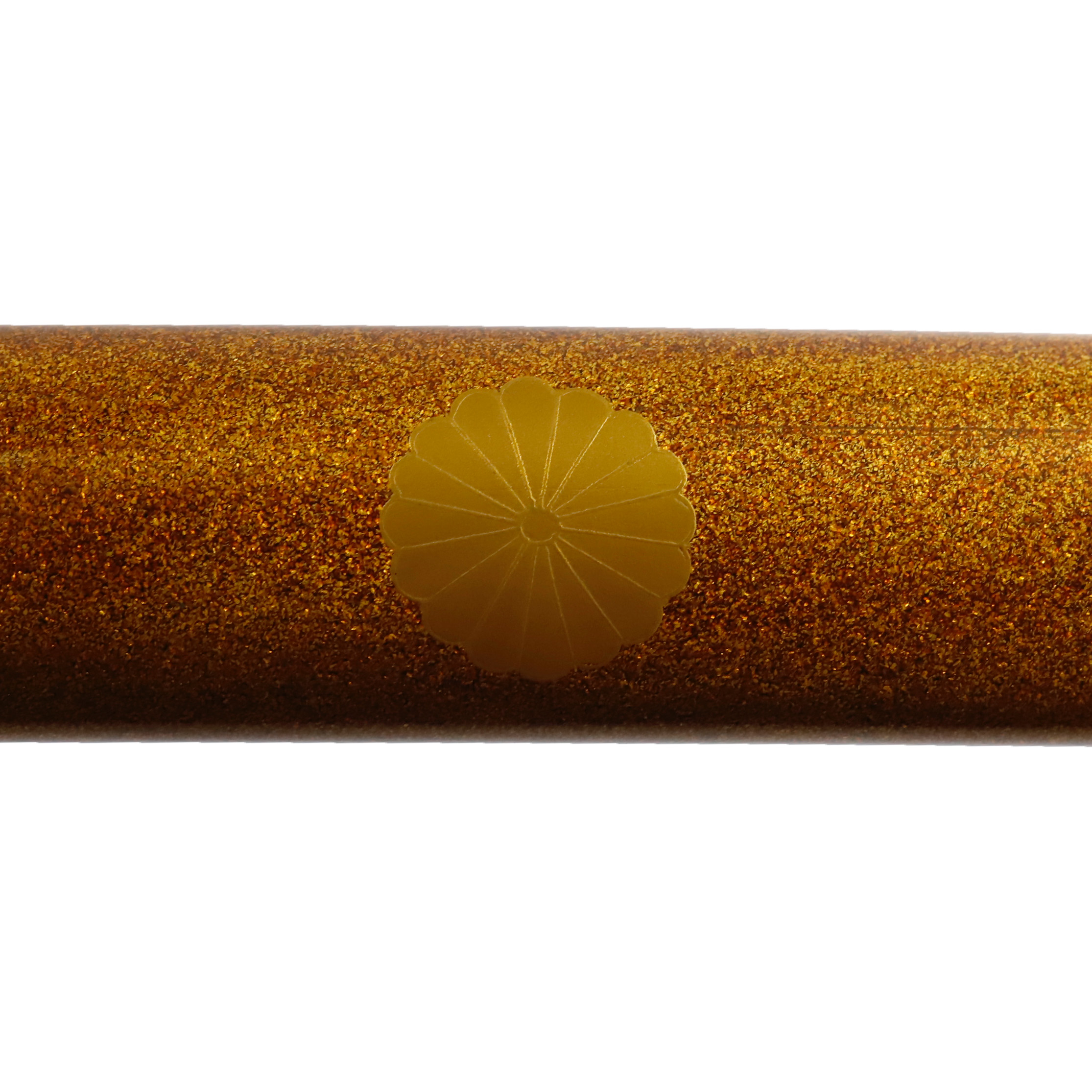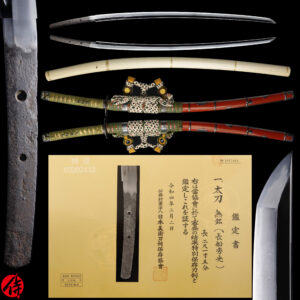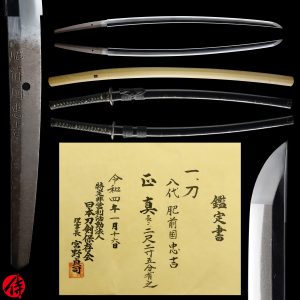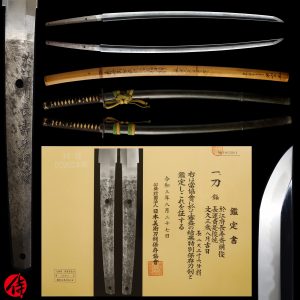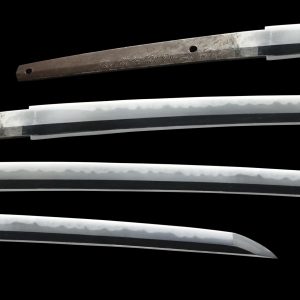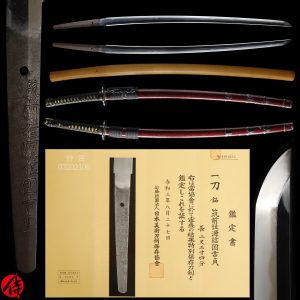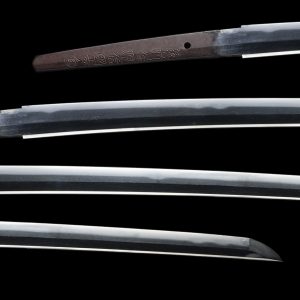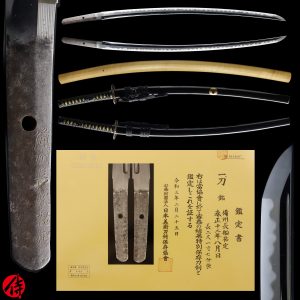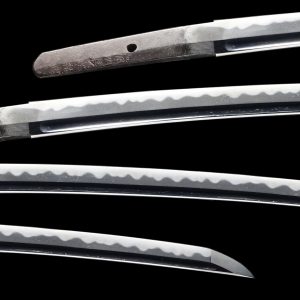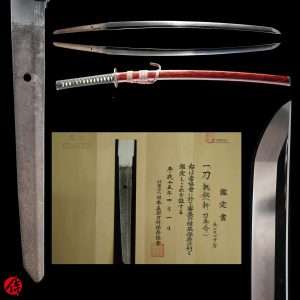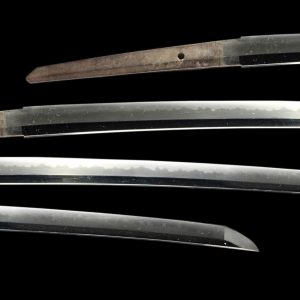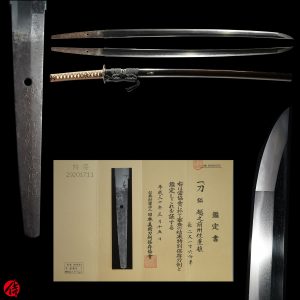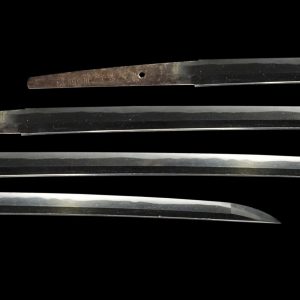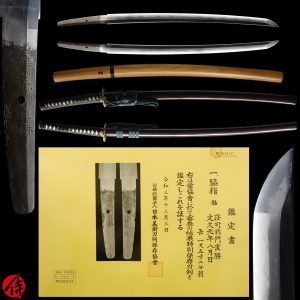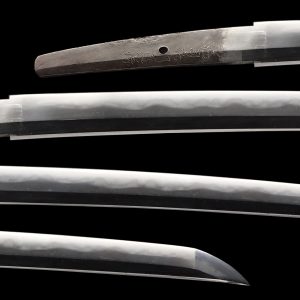Modern Authentic Japanese Sword Tachi Signed by Izu Jyu Yusuishin Sadayoshi
【Description】
This blade was signed by Izu Jyu Yusuishin Sadayoshi (伊豆住湧水心貞吉) in the 10th year of the Heisei era (1998), when he was 90 years old. Izu Jyu means that he resided in Izu city in Shizuoka prefecture when he forged this blade.
He was born in Tokushima(one of Shikoku island) in 1908. After finishing his primary education, he left his hometown and started to work at an iron factory in Osaka.
In 1928, he started to work for Gassan Sadakatsu(月山貞勝) as an apprentice. His master’s father was Gassan Sadakazu(月山貞一), who was designated as a living national treasure in 1906. Sadayoshi started his career as a swordsmith by learning skills from one of the greatest swordsmiths.
He became an independent sword maker after his master’s death in 1943, moving to Mishima city in Shizuoka prefecture. He used special spring water coming from Mount Fuji to forge his swords. He called himself Yusuishi(A child of Spring Water) and signed this word before his signature(Sadayoshi).
Sadayoshi was excellent at forging Soshu-Den style swords There are so many great swordsmiths among Gassan school, but Sadayoshi was known as a specialist in forging and tempering.
Gassan school’s origin dates back to the Kamakura period and one of the oldest Japanese swords that even exists today.
He received awards in many exhibitions and was eventually designated as Mukansa swordsmith by NBTHK(Nihon Bijutsu Touken Hozon Kyokai). He left many great works until he died at the age of 92.
You can observe his outstanding craftsmanship from this blade and feel the vitality he had. He survived during world war Ⅱ and kept forging swords for the rest of his life.
Based on the registration paper, this blade was created as a Tachi sword. It comes with a Tachi(太刀) Koshirae. Tachi was mainly used by an armored Samurai with one hand on horseback from the Heian period (794-1185 A.D.) until the early Muromachi period. TACHI was suspended loosely on the left waist with its edge facing the ground so that you could draw it faster to cut down soldiers on the ground. Because of its gorgeous looking, having a Tachi-style sword mounting became a social status among Samurai. We presume this sword mountings are antique ones.
*What is Mukansa swordsmith?
It is one of the most honorable titles a modern swordsmith could receive.
One with this title could submit his work to the Japanese sword exhibition held by NBTHK(Nihon Bijyutu Touken Hozon Kyokai) without being examined. In contrast, other sword makers need to pass a rigorous test to participate in this event. This fact also suggests he was a great swordsmith in modern times. There are only 39 Mukansa swordsmiths now since the exhibition started in 1955. This exhibition is held by NBTHK once a year, and modern swordsmiths compete for their craftsmanship there.
About Modern Swordsmith
There are around 150-200 swordsmiths in Japan today. To legally produce Japanese swords, one needs to pass the national exam given by the Agency for Cultural Affairs(Bunka-Cho) and receive the license. Before taking the exam, one must finish his or her apprenticeship under a licensed master for more than five years.
Those who practice Iaido(居合道) tend to use those modern swords, and there are modern Japanese sword collectors nationwide.
The modern Japanese sword makers are researching old ways to forge swords and trying to recreate ancient style swords. They are the ones who keep the tradition of Japanese history alive.
【 Blade】
Cutting Edge Length(Nagasa): 72.4 cm ( 28.5 inches)
Curvature(Sori): 1.8 cm (0.71 inches)


Hamon:
The crystalline structure which forms along the cutting edge of a blade as a result of the hardening process
Jimon(Jihada):
visible steel surface pattern created by folding and hammering during forging process
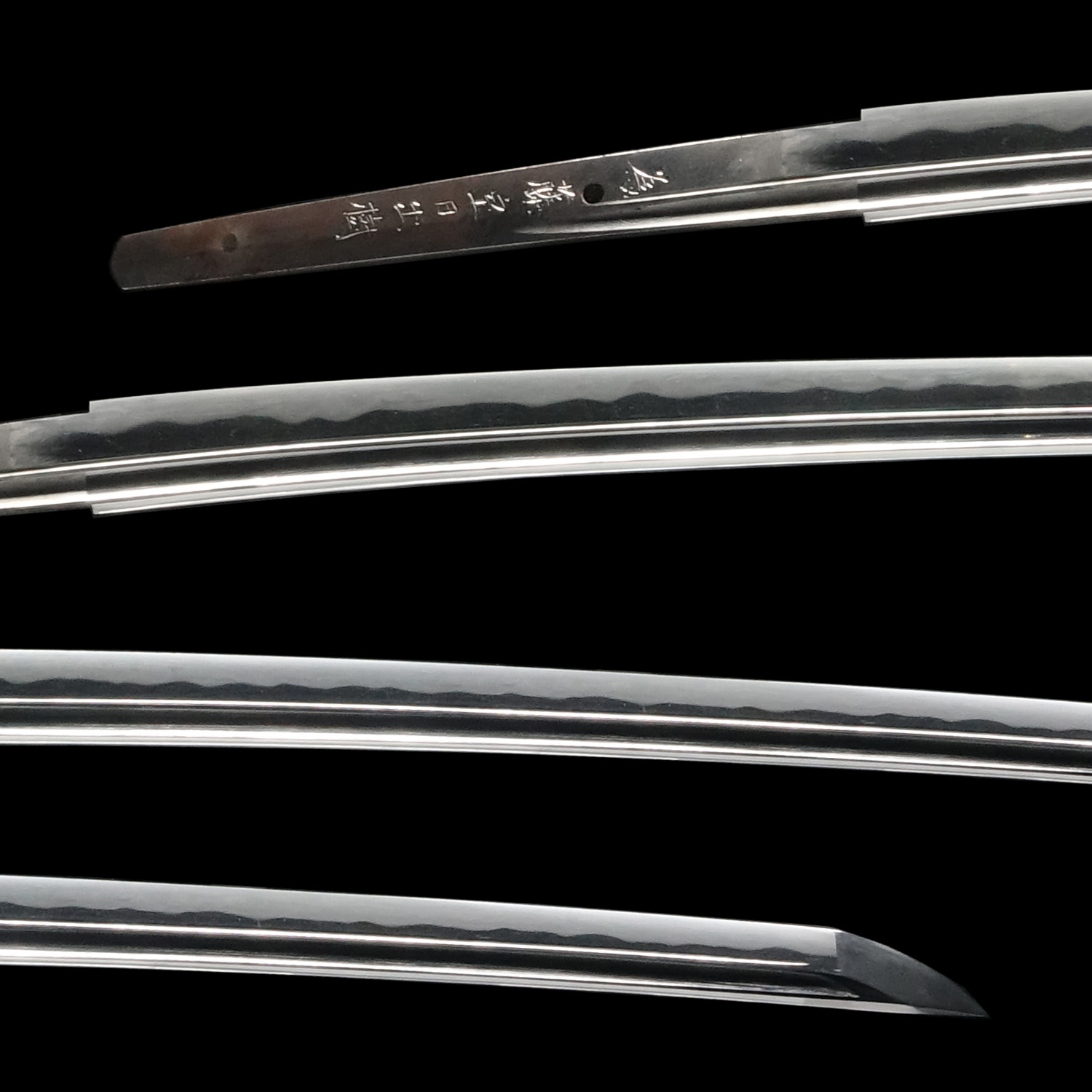
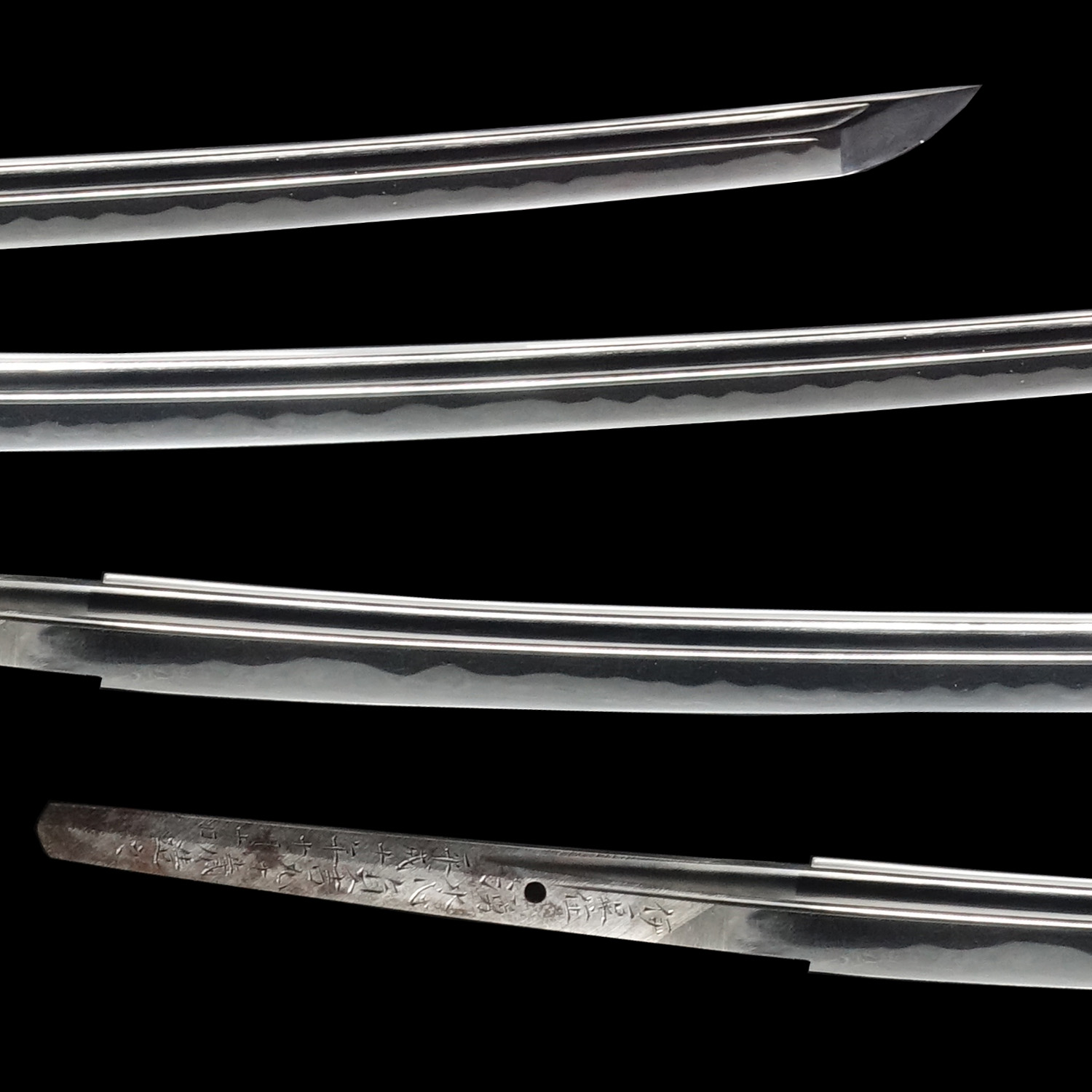
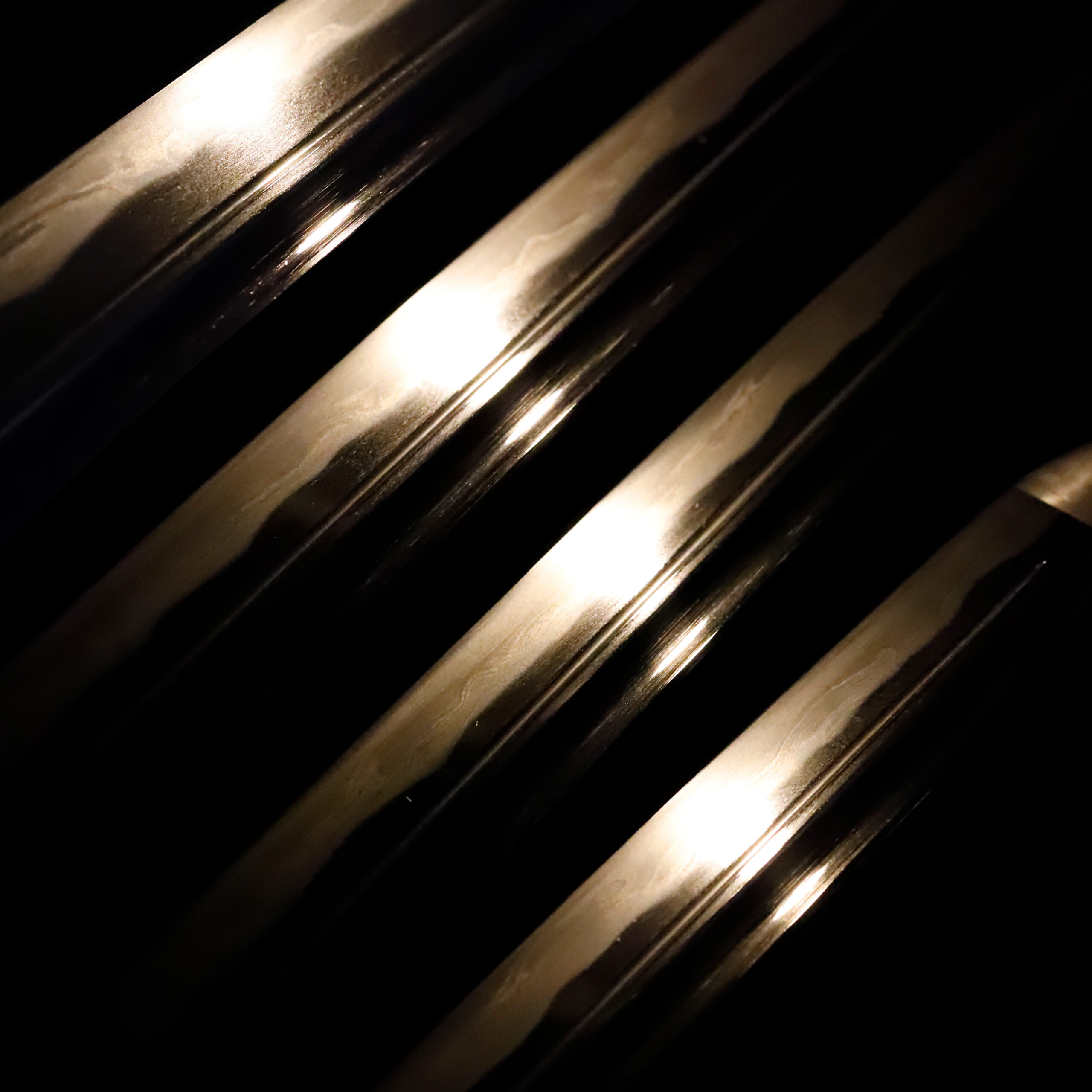
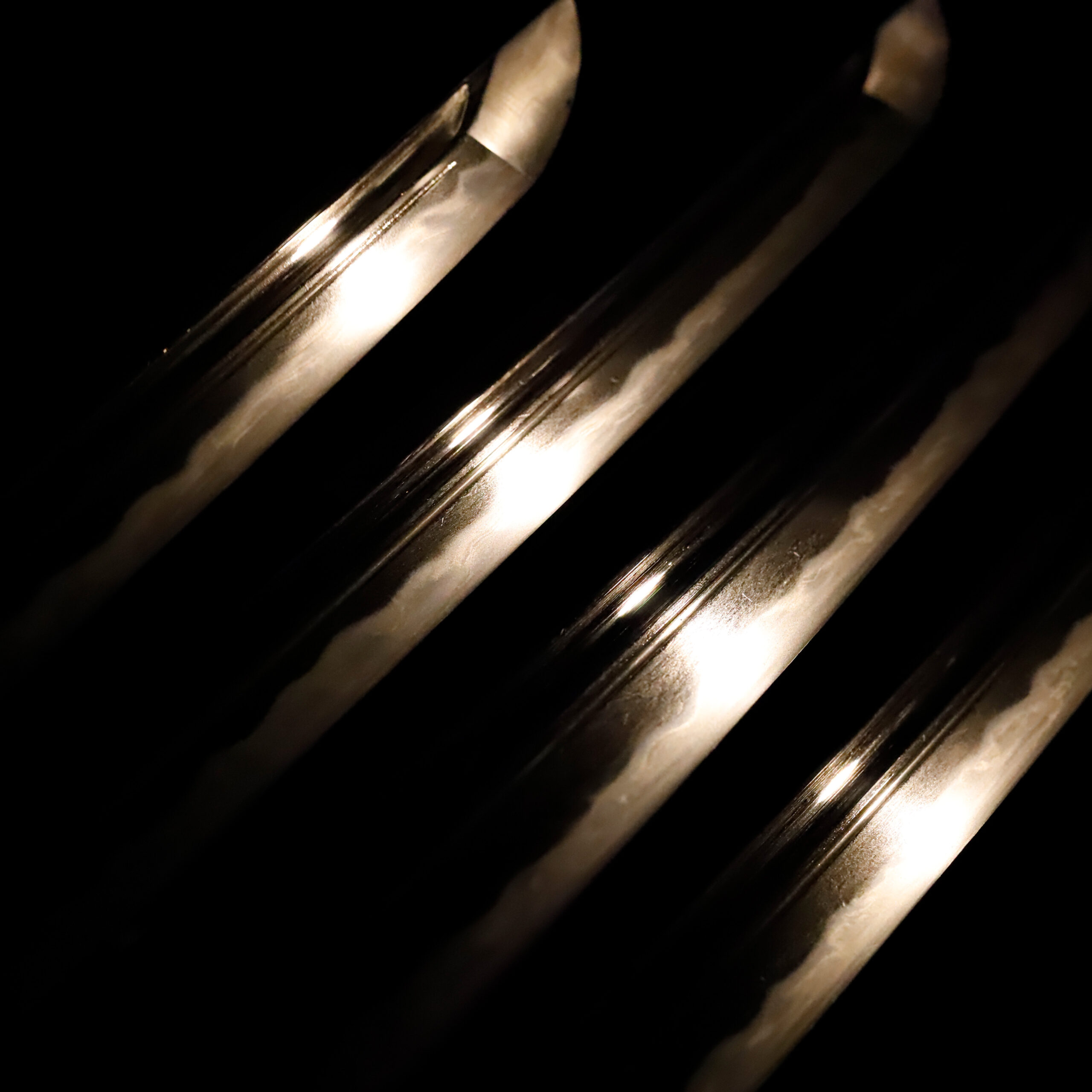


Nakago:Nakago is the tang of the Japanese sword.
Japanese swordsmiths left the black rust on the tang because it prevents red rust while the tang is in its handle. And the discoloration of the tang was created over time, and it is a great indicator for a Japanese sword specialist to estimate when the sword was forged.
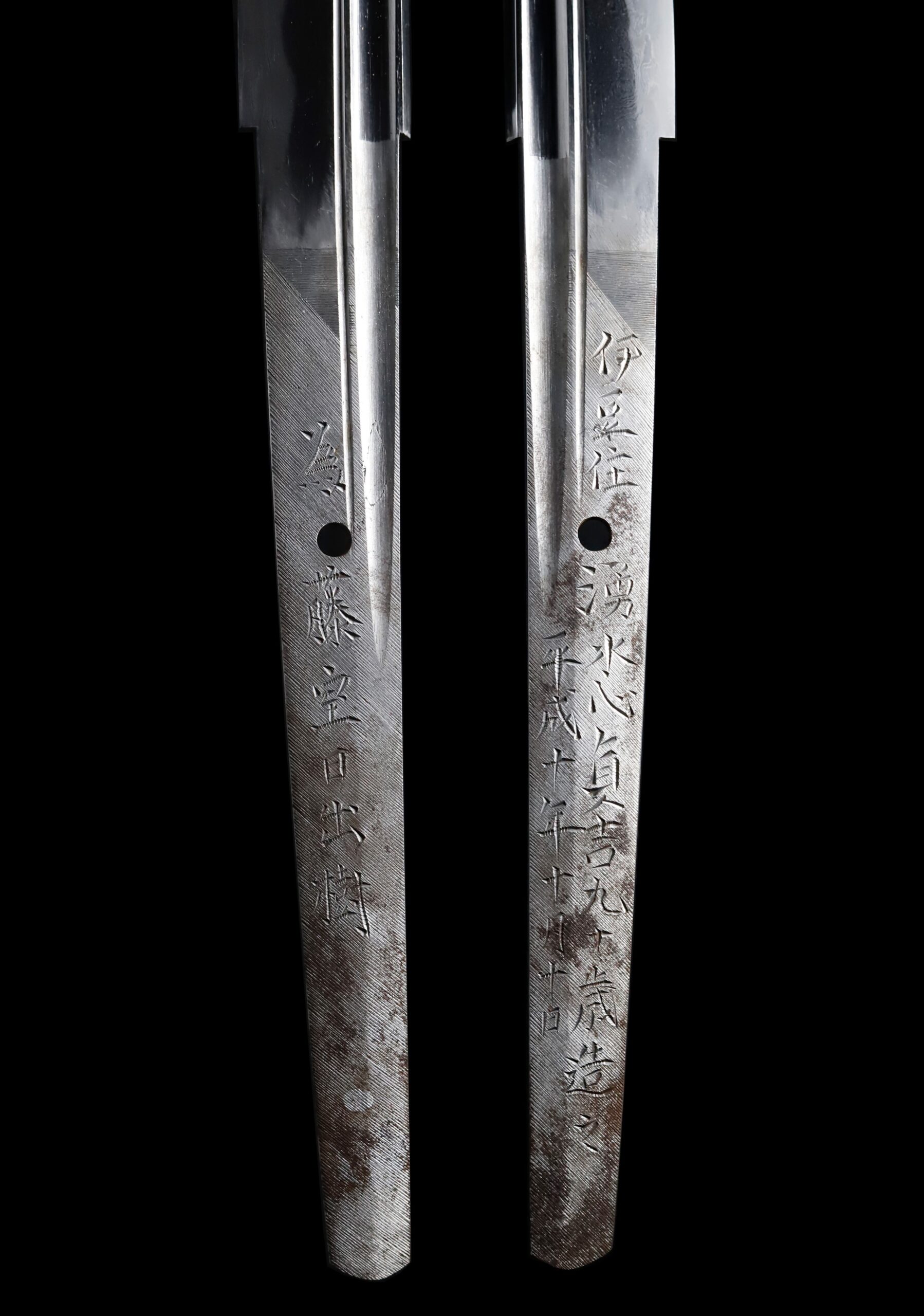
Koshirae: Koshirae is the mounting of the Japanese sword. There are several parts that consist of Koshirae such as Saya(Scabbard), Tsuka(Handle), Tsuba(Handguard).
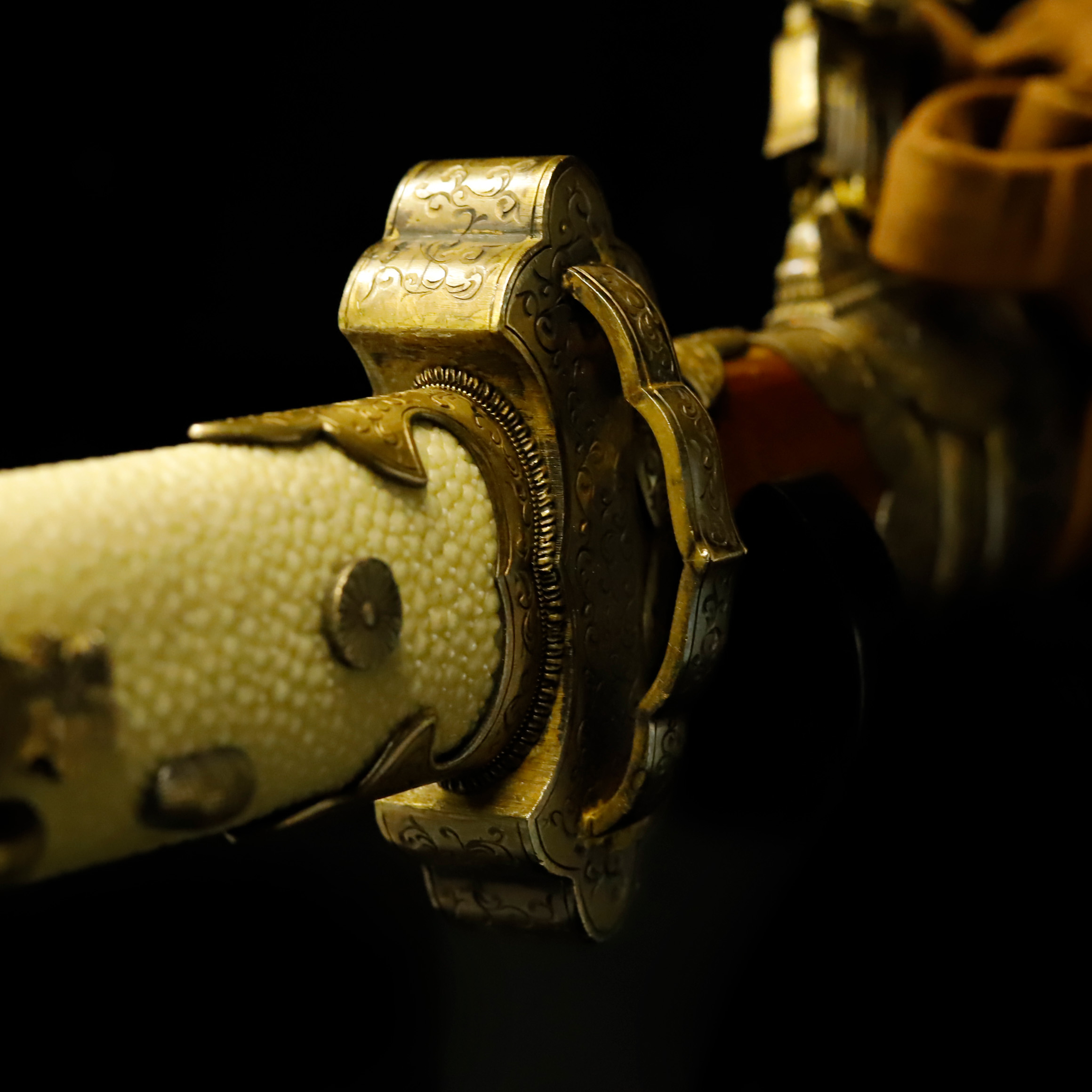
Fuchi-Kashira:A pair of matching sword fittings that cover the upper and bottom parts of its sword hilt.
The Kabutogane (冑金/兜金) is a metal fitting that is attached to the end of a handle. And a Sarute/Sarude (猿手) is attached to this Kabutogane. The user of a sword passed the Udenukio (腕貫緒, a cord wrapped around the wrist to prevent a sword from falling out of the hand, mainly used when riding a horse) through this ring. And the Fuchi Kanamono (縁金物) is also a metal fitting attached to the handle, but on the opposite side of Kabutogane.
This Kabutogane and Fuchi Kanamono are decorated with the same design. It is a pattern of curved and intertwined vines. This design is called the Karakusa (唐草, arabesque) pattern. Other sword mountings and metal fittings of this Koshirae have the same design, such as the Tsuba, Ishiduki Kanamono (石突金物, a fitting attached to protect the distal end of the scabbard), etcetera.
The Karakusa pattern is a design in which stems and leaves of vines are twined and make curves. Since ivy has a strong vitality and grows up without interruption, people regarded this design as a symbol of prosperity and longevity. Vine is called Tsuru (蔓) in Japanese and has another pronunciation; “Man.” There is a word 万 (it is also read Man), which means ten thousand. In the Karakusa pattern, leaves and vines are connected like Obi (帯, belt). The word “帯” can also be read as “Tai.” Due to its pronunciation, the term “代 (Tai)” is associated. From this word-association game, an idiom 万代 is associated, meaning a thousand generations. In other words, we could imagine that people used this design wishing prosperity and longevity for their clans for a long time.
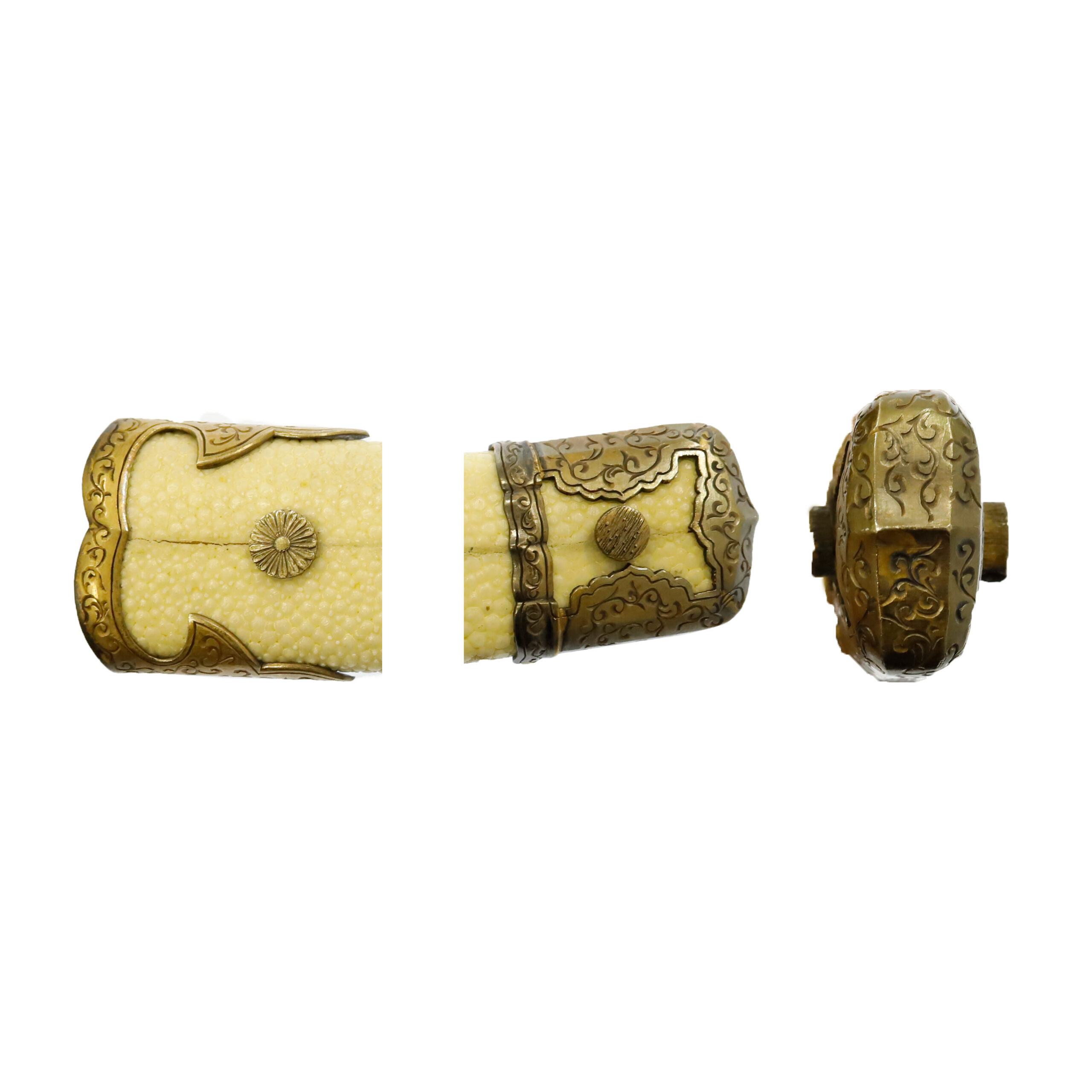
Tsuka and Menuki:Tsuka is the handle of the Japanese sword and Menuki is its decoration.
This Menuki comprises one Kiku (菊, chrysanthemum) and two Kiri (桐, paulownia) patterns.
A long time ago, the chrysanthemum was used as a medicine for obtaining a long life on the continent, and it was brought to Japan with this thought in the Nara period (648-781). Chrysanthemum symbolizes fall, and people have greatly appreciated it since ancient times. As its petals form radially, the chrysanthemum has been likened to the sun. That is why this flower pattern is treated as the symbol of perpetual youth and longevity or good health. The Kiku-no Gomon (菊の御紋) is a kind of chrysanthemum pattern, and it has been used as the crest of the Emperor and the royal family in Japan, so it is well-known as a noble pattern. This Kiku-no Gomon is designed on the scabbard. Please check the enlarged photos of the sheath.
The paulownia pattern generally comprises three standing straight inflorescences and three leaves. The number of flowers blooming at each inflorescence shows the ranks of this design. It is also famous that one of the most popular Samurais in Japan: Toyotomi Hideyoshi used the Kiri pattern for his family crest. According to a theory, Hideyoshi used Omodaka (沢瀉, arrowhead) pattern as his family crest. However, Oda Nobunaga, a well-known military commander in the Warring States period, permitted Hideyoshi to use Kiri design. his family crest is the Go-Shichi-no Kiri Monyou (五七の桐文様); Go (五) means five, and Shichi (七) means seven. If you focus on the number of flowers of each inflorescence in this Menuki’s paulownia, you will see that the flowers are attached in the order of five, seven, and five. It is more gorgeous than the similar patterns described later and is regarded as a higher-ranking pattern. Chrysanthemum and paulownia, both of which are elegantly made to order with high-class designs.
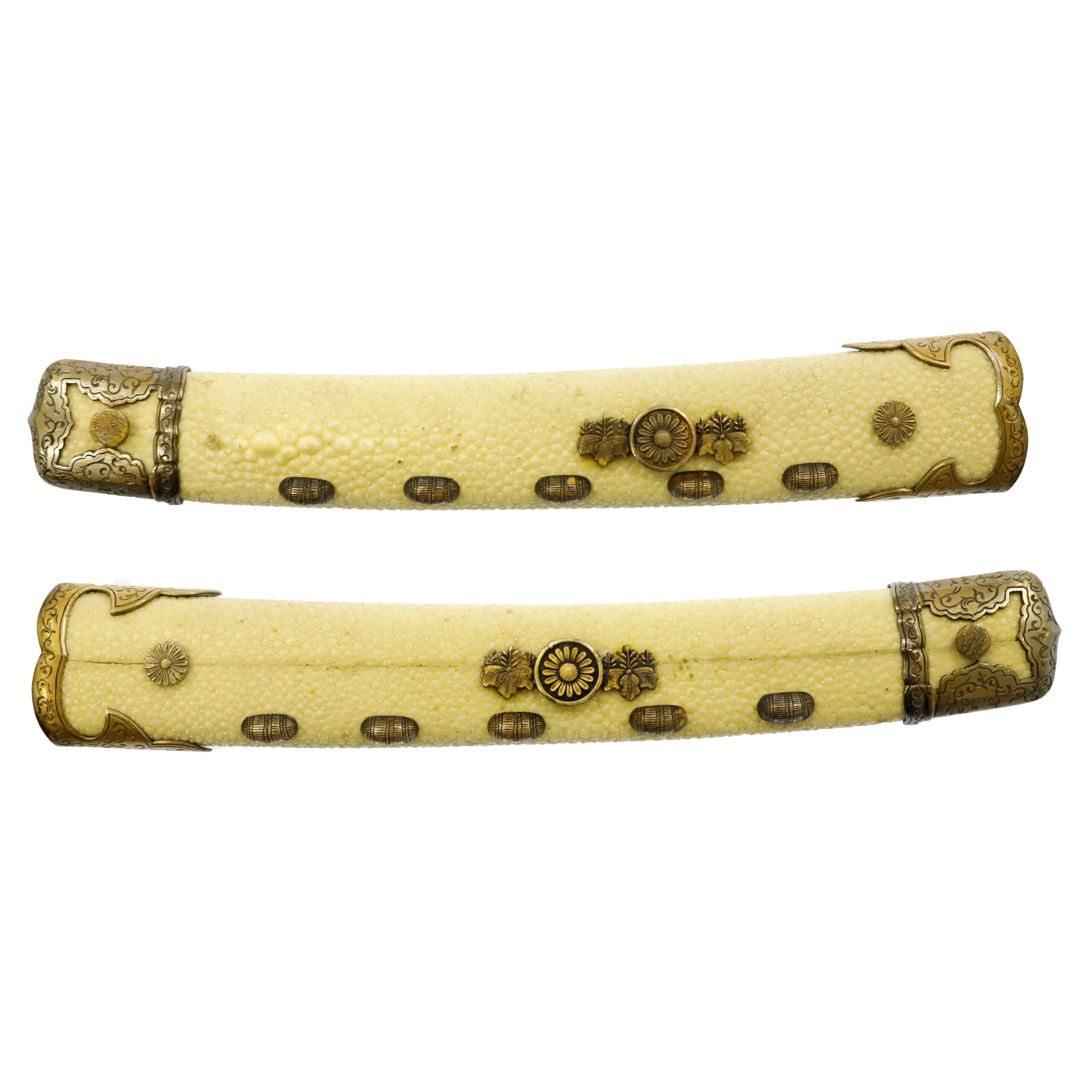
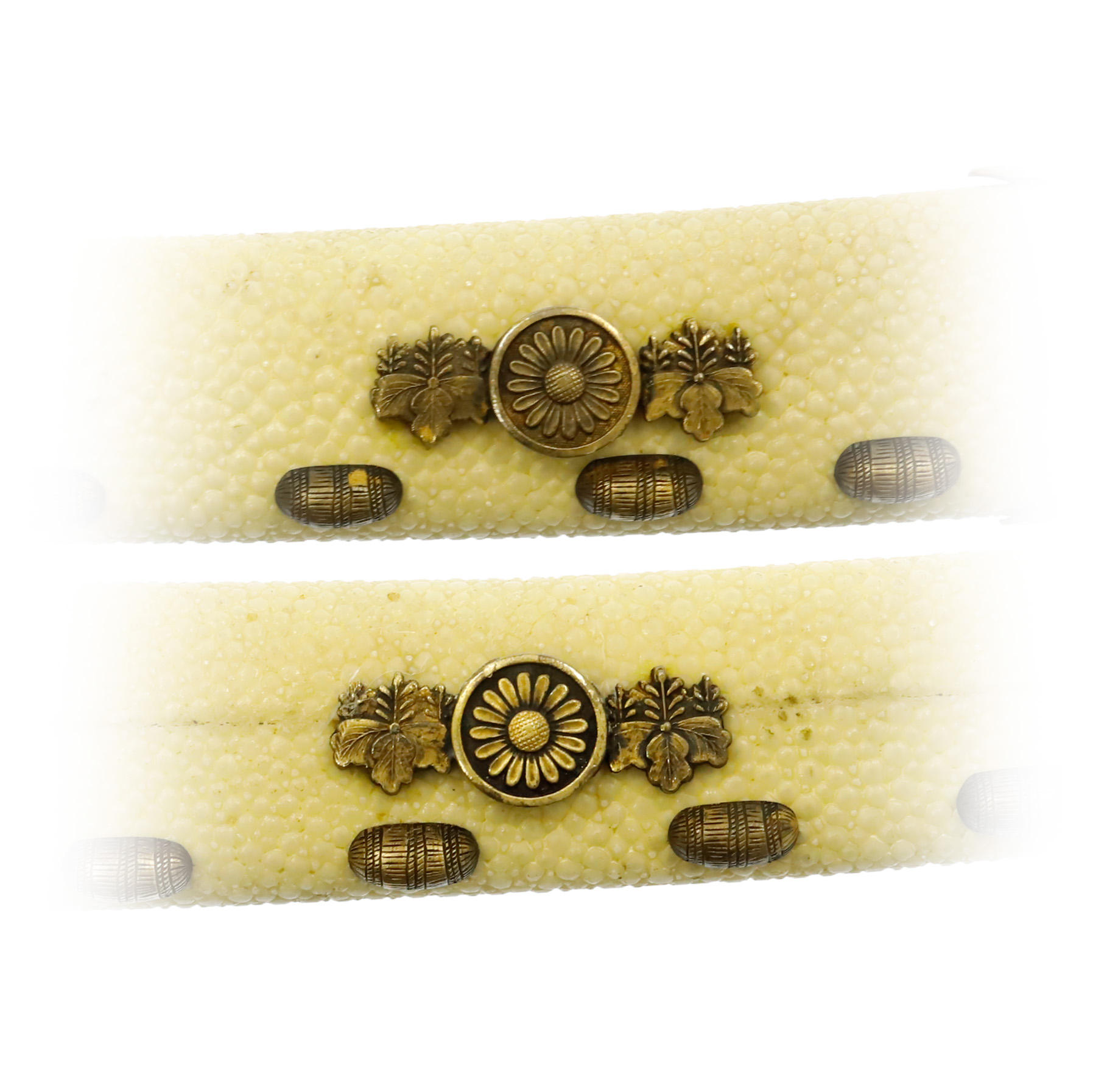
Tsuba and Habaki:Tsuba is the handguard for the Japanese Sword and Habaki is the equipment to make the blade not touch its scabbard inside. It prevents the blade from getting rusty and chipped.
This Tsuba is categorized as the Kara Tsuba (唐鐔). This type of Tsuba was initially used for the Kara Tachi (唐太刀)-style Koshirae. The continental style changed to the Japanese style during the Heian period (794-1185), and it came to be applied to decorative swords for ceremonial purposes. The Kara Tsuba was also called the Hundou Tsuba (分銅鐔) because its shape was similar to the Goto Hundou (後藤分銅, a type of weight) used in the Edo period.
*Please keep in mind that one side of the thin rounded metal is dented due to the damage in the past.


Saya: Saya is the scabbard for the Japanese sword.
As mentioned above, the Kiku-no Gomon is applied to golden paint on this scabbard. It is also called the Kikka-Mon (菊花紋) or Kikka-Monsyou (菊花紋章). This design emphasizes the petals of chrysanthemums, and you would find sixteen petals.
In the Kamakura period, the retired Emperor Gotoba (後鳥羽上皇, 1180-1239) was particularly fond of chrysanthemum crests, and subsequent emperors inherited chrysanthemum crests as their own crests. It is said the chrysanthemum motif has been conventionally established as the crest of the imperial family.
On the opposite side of this scabbard, you would find that the Gosan-no-Kiri Monyou (五三の桐文様) is depicted. It is a popular design that the paulownia motif is used. This pattern was once used by the imperial family and people in authority at that time. Today, it is permitted to use by ordinary households and is appreciated as their family crests. According to a tradition, the Houou (鳳凰, Fenghuang, a kind of sacred beast) rests its wings at the paulownia tree; therefore, it has come to be regarded as a sacred plant.
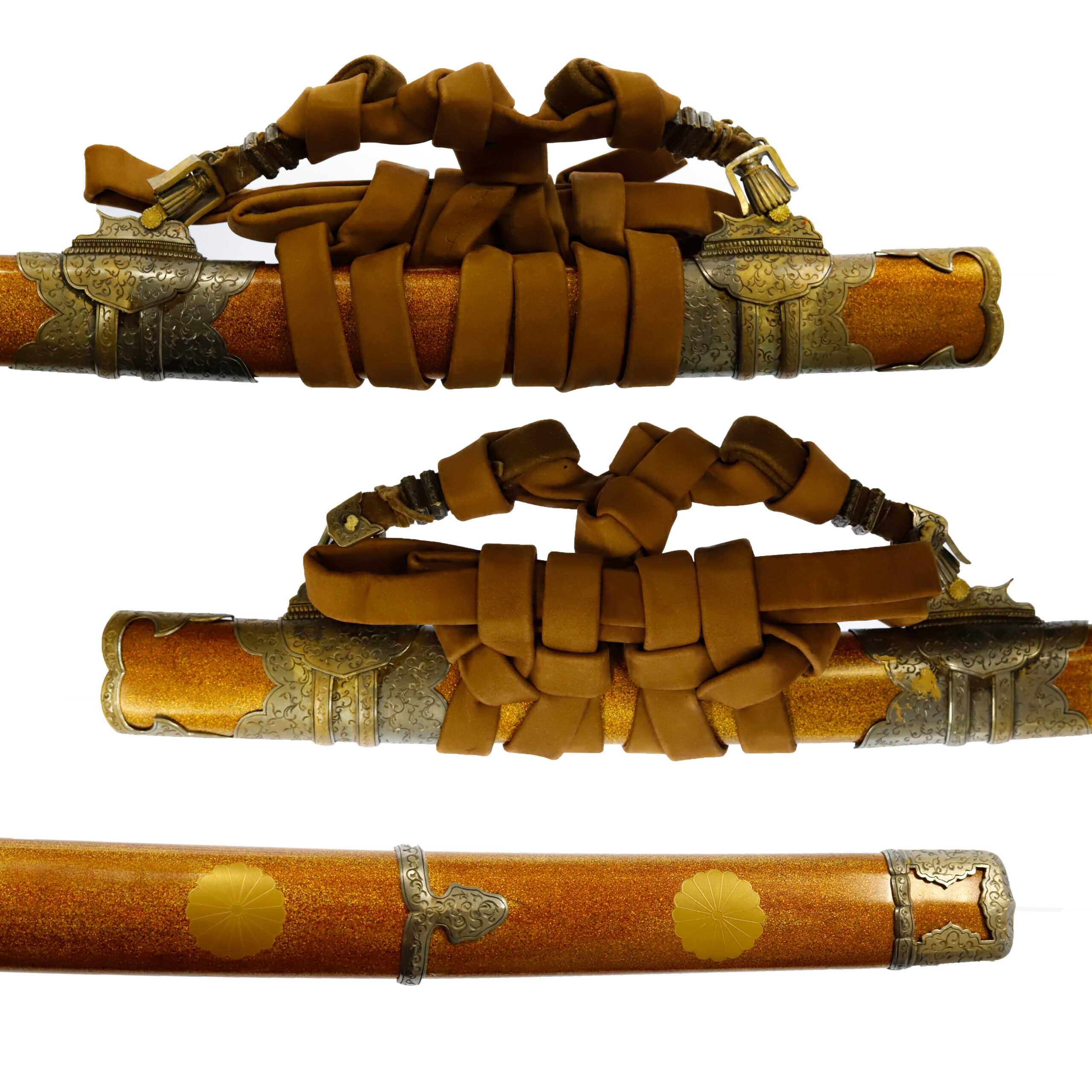


Registration Number : Shizuoka 65879
The Board of Education in Shizuoka prefecture issued a registration paper for this sword . It is called Jyu Token Rui Torokusho(銃刀剣類登録証). Bunkacho(The Agency for Cultural Affairs) acknowledges a Japanese sword with this paper as a work of art.
The sword needs to be traditionally hand-forged and made of Tamahagane carbon steel to be registered in the system. With this paper, its owner in Japan can legally own an authentic Japanese sword. Based on this registration number, we will apply for its export permit.
This paper will need to be returned to the board of education when the sword is being shipped abroad, but you can receive a copy of it. An English translation of this registration paper is available on request.
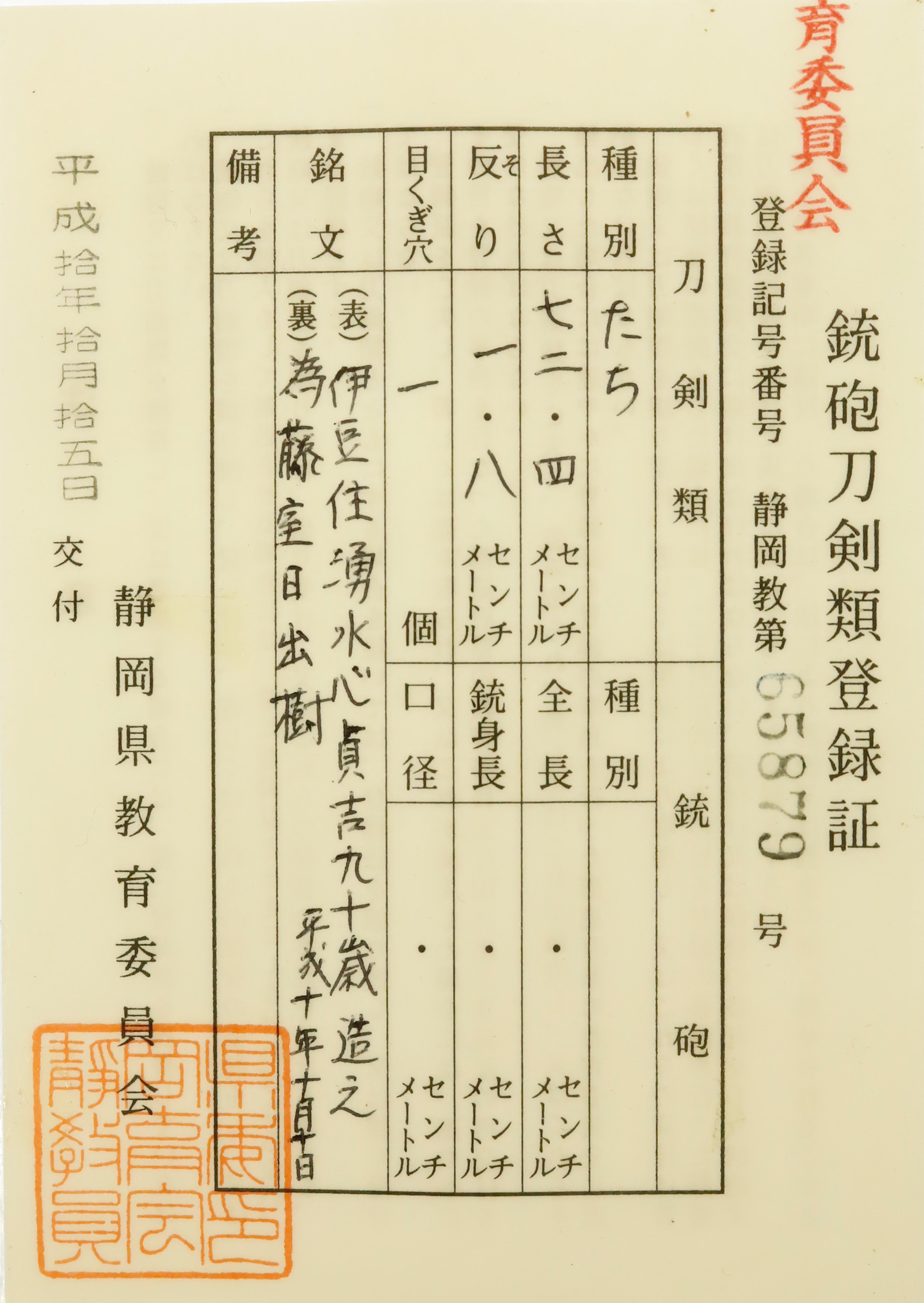
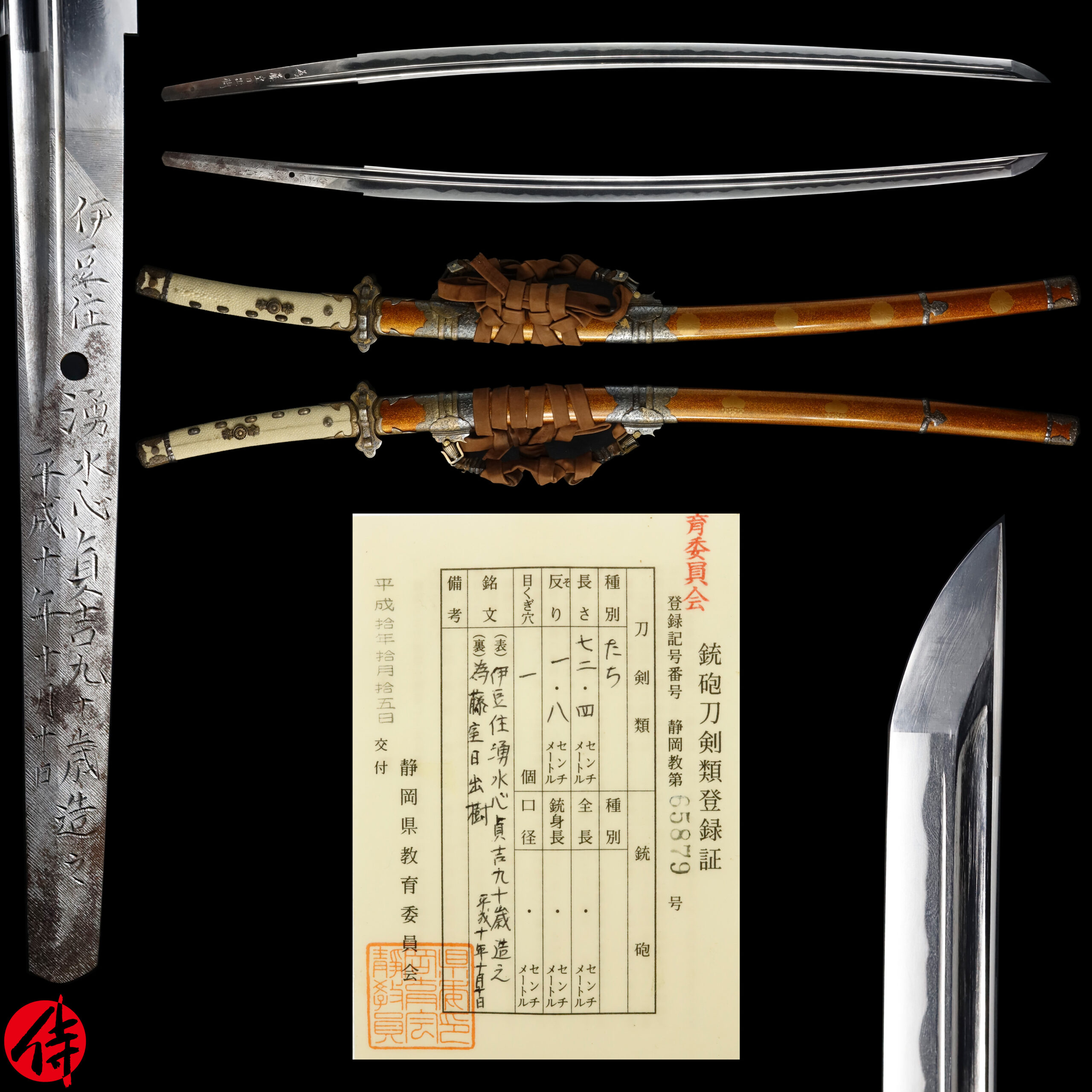
—————————————————————–
【About us】
Samurai Museum is located in Tokyo, Japan, exhibiting antique artifacts related to the Samurai history. Samurai Museum Shop is the place for those who are interested in Japanese culture and craftsmanship. We deal with antique Samurai swords/armor, traditional crafts made in Japan and so on.
【Japanese Sword& Export Process】
The Japanese swords we deal with are hand-forged edged swords made in Japan. It was made from the traditional carbon steel called TAMAHAGANE(玉鋼). Samurai Museum is familiar with the proper legal procedure for an antique/ authentic Japanese sword to be exported from Japan. We have sent more than 500 Japanese swords for the past three years (~2023) to amazing owners who appreciate its historical value.
Each Japanese sword is registered under the Agency for Cultural Affairs and the Board of Education in Japan. They issue a registration paper for each Japanese sword for its owner in Japan to legally possess it. The Japanese sword with its registration paper means it was traditionally hand-forged in Japan.
To legally export the sword from Japan to other countries, we will have to apply for its permit to the Agency for Cultural Affairs(Bunkacho) and return the original registration paper to the Board of Education. It normally takes around 2-4 weeks to receive this permit after submitting required documents. And we would like you to expect at least 1-1.5 months for your order to arrive at your given address after you ordered. For more detailed info, please click here.
It is allowed for residents in Japan to own authentic Japanese swords without a special license as long as they come with registration papers. Please feel free to contact us if you are a resident of Japan, whether temporarily or permanently. We will also assist you when you leave Japan and need to obtain the export permit.
【Payment Method】
We accept payment through Stripe (Credit card), PayPal, Apple Pay or ChromePay, all of which are secure payment methods. Also, you don’t need to make an account on Stripe for the checkout. If you prefer other payment method, please contact us. After confirming your payment, we will apply for an export permit. You may either pay in JPY, USD, AUD, CAD,EUR CHF or GBP. The price is set in Japanese Yen. Prices in other currencies are automatically calculated based on the latest exchange rate.

* If the amount is above 1 million JPY, Stripe or wire transfer will be the only options for payment.
【Shipping】
We have shipped authentic Japanese swords to the USA, UK, Canada, Mexico, Germany, Switzerland, France, Hong Kong and Australia. If you don’t live in these countries and like to order, please contact us first before making a purchase. We offer Free International Shipping as long as we can send antique Japanese swords by EMS.
We normally ship by EMS(Express Mail Service) provided by Japan Post. We will send you a tracking number for your order as soon as we hand it to the post office. We will put 100 % insurance on the shipping document without any extra charge. Based on the total amount, there might be a duty tax or other fee for you to pay, depending on the countries. We use package cushioning to protect the item and put it in a PVC pipe, which is one of the most secure packages because of its durability.
It will normally takes 5-14 days for the item to arrive at your given address after we dispatch it. Time of delivery is estimated as accurately as possible by the carrier but does not take into account any delays beyond our control such as by inclement weather, post office holiday seasons.
* If you live in Australia and like to purchase an authentic Japanese sword, please click here to know the detail.
*Please keep in mind that due to the spread of COVID-19, there might be delays in shipping. If you like to know the detail about shipping, please feel free to ask us.

【Review】
Here is one of the reviews we received from a customer who purchased an authentic Japanese sword from us. For more reviews, please click here.
“My experience overall with the whole process was wonderful. I had many questions about the history and process to purchase these treasures. All my questions were answered very timely and complete. The staff is very knowledgeable and very well versed if any questions do arise.”
【How to make sure the condition】
Please keep in mind that what you are going to purchase is an antique item. We uploaded high resolution photos for you to check its condition thoroughly. If you like to see more photos with different angles, please feel free to contact us. We will be happy to send them to you so that you can make informed decision. It is essential for us to know that you are happy with your choice of a sword. and we are prepared to use the best of our ability to serve you.
【How To Contact Us】
Please contact us through email, Facebook Messenger or Live Chat if you have any questions. You can find each icon on the right side of the website. Please click one of them to reach us. We will reply to you within 1-2 business days.
【The Art of Nihonto (Japanese Sword)】
Samurai’s history is a profound, eloquent legacy of ancient Japanese warriors in which millions of people worldwide are being fascinated. If you like to find out the art of Nihonto, please click here.
【A Guide to Japanese Sword Maintenance】
After acquiring an genuine Japanese sword, it is also important to know how to take good care of it. Here is the special video for you. Mr. Paul Martin, Japanese sword expert, shows you how to give proper maintenance to your sword. By mastering how to clean the Japanese sword, its aesthetic beauty will last forever.
When you purchase a Japanese sword from us, you can get a Free Japanese sword maintenance kit. It comes with four tools(Choji Oil, Uchiko Whetstone Powder, Peg remover, Oil Applicator). By watching the video instruction above , you can enjoy learning how to maintain your Japanese sword while appreciating it. If you have any difficulty assembling the sword or cleaning the blade, you can feel free to contact us.


MORE ANTIQUE JAPANESE SWORD FOR SALE
SWORDS WITHOUT CERTIFICATES FOR SALE
LEARN JAPANESE SWORD TERMINOLOGY
Thank you for reading all the information on the page. If you have any difficulty choosing the right Japanese sword for you, we will be more than happy to help you find the one that speaks to you the most. Please feel free to contact us.
